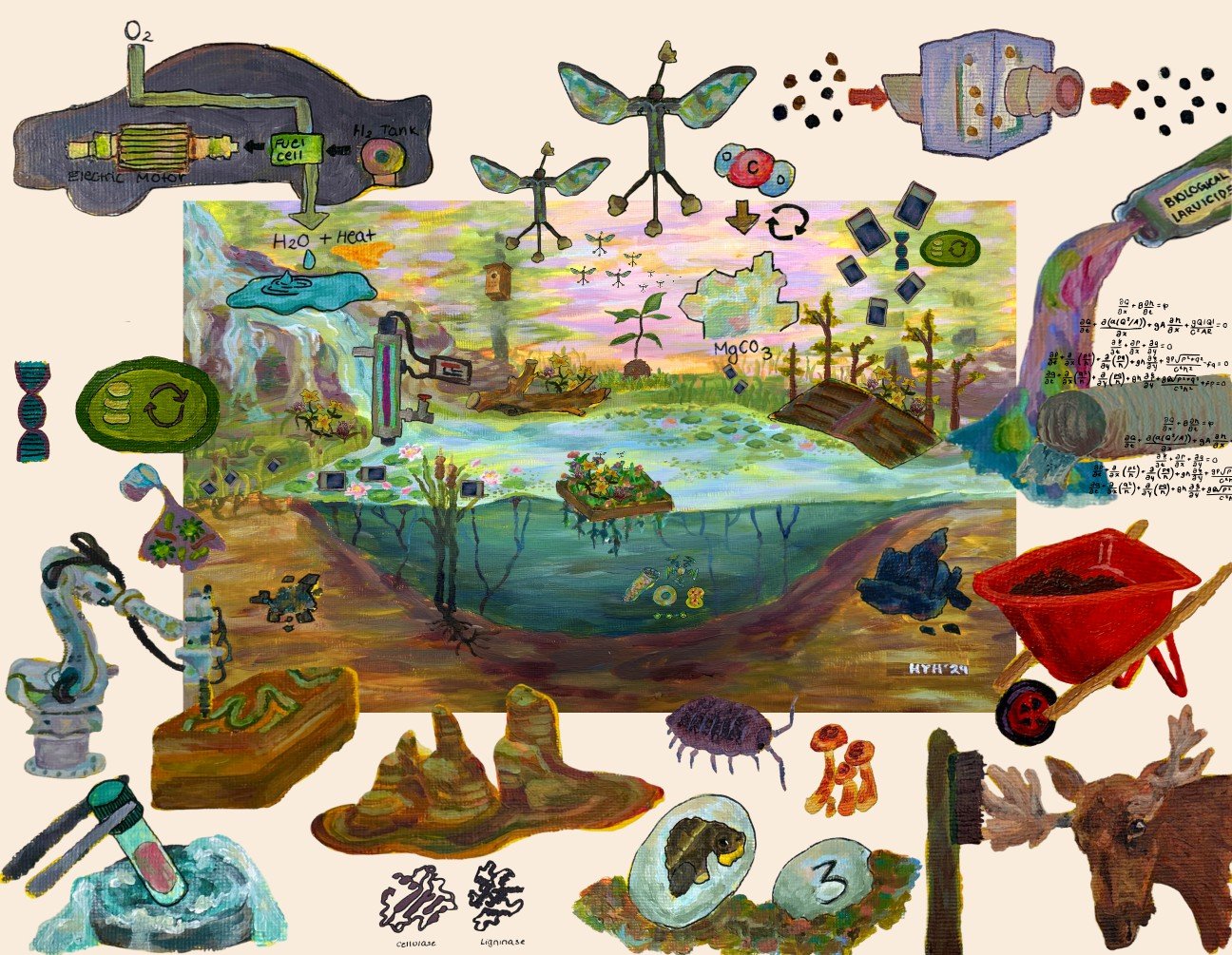
Wetland Ecosystem Services Necessary to Support Wildlife
“Wetland Ecosystem Services Necessary to Support Wildlife" is a research initiative led by Hannah Hiemstra, a Master of Wildlife Biology student at the University of Guelph.
The project examines the future of wildlife conservation in a manufactured ecosystem through a detailed case study of wetlands. By adapting the Ecosystem Services Framework - originally designed from an anthropocentric perspective - to a wildlife-centered approach, the project investigates the critical ecosystem services that wetlands provide to support wildlife, while exploring the potential of technology to enhance or replace these natural processes in response to the pressures of climate change.
The project integrates scientific research with artistic expression (medium: acrylic) to communicate its findings. It begins with an infographic that succinctly summarizes the key ecosystem services provided by wetlands for wildlife. Subsequent phases will identify and evaluate current technologies, document emerging conceptual ideas, and highlight gaps in existing knowledge. Ultimately, the work seeks to develop a critical thinking framework applicable to various ecosystems beyond wetlands, thereby encouraging innovative conservation strategies and opening doors for more effective climate communication through art.
ENHANCE
Hover to highlight the biomimetic technology
Provisioning
-
Biodiversity - Captive Breeding: support species conservation by rearing and reintroducing animals to bolster wild populations.
-
Clean water - Nanotechnology Application: using nanoparticles in water treatment to remove pollutants by adsorbing contaminants, breaking down toxins, and neutralizing harmful microbes at the molecular level.
-
Shelter and habitat material - Woody Debris Placement: provides cover, refuge, and structural complexity for wetland-inhabiting species.
Regulating
-
Climate Regulation - Humic Acid Application: increases carbon residence time, enhancing carbon sequestration and reducing atmospheric CO₂.
-
Coastline Regulation - Vegetative Buffer: reduces erosion by stabilizing soil, absorbing wave energy, and trapping sediment to protect shorelines.
-
Disease regulation - Floating Treatment Wetlands: reduce waterborne disease by filtering contaminants, absorbing excess nutrients, and supporting microbial communities that break down pathogens.
-
Waste Treatment - Biochar Integration: facilitates the absorption of contaminants, improves nutrient retention, and supports microbial decomposition in soil and water systems.
-
Water Regulation - Organic Matter Supplementation: increases water retention capacity by enhancing soil structure, increasing moisture absorption, and reducing runoff.
-
Atmospheric Regulation - Conceptual: explore further research and development for CO2 absorption filter technology, aiming to scale up carbon capture capacity for atmospheric CO₂ reduction.
-
Pollination - Plant Native Blooms: enhances pollinator activity by providing natural sources of essential nectar, pollen, and habitat for native pollinator species.
Supporting
-
Soil Formation - Microbial Inoculation: introduces beneficial microorganisms that improve nutrient cycling, organic matter decomposition, and soil structure development.
-
Nutrient Cycling - Detritivore conservation: maintaining populations of decomposers that break down organic matter and release essential nutrients back into ecosystems.
-
Primary Production - Photosynthesis Optimization Strategies: enhancing light reactions, Calvin cycle efficiency, carbon concentration, photorespiration, and gas exchange using synthetic biology and de novo domestication.
Cultural
-
Species Enrichment - Conceptual: restoring natural enrichment by enhancing historical ecological conditions that naturally provided stimulation, shelter, and resources for wildlife.
REPLACE
Hover to highlight the biomimetic technology
Provisioning
-
Biodiversity - Cryopreservation: Storing viable cells and tissues in cryobanks to preserve genetic material and enable future species regeneration.
-
Clean water - Conceptual: purify water that was generated as a byproduct of chemical reactions, such as fuel cell technology.
-
Shelter and habitat material - Artificial habitats: using man-made structures to provide shelter, nesting sites, and refuge for wildlife in modified environments.
Regulating
-
Climate Regulation - Conceptual: Chemical Carbon Sequestration: capturing CO2 and converting it into stable, long-lasting materials like magnesium carbonate (MgCO3).
-
Coastline Regulation - Revetements: engineered to protect shorelines by absorbing wave energy and preventing erosion.
-
Disease regulation - Biological larvicides: control insect larvae populations to reduce disease-carrying vectors and prevent transmission.
-
Waste Treatment - UV-C disinfection systems: use ultraviolet light to destroy pathogens, sterilize waste, and prevent contamination.
-
Water Regulation - Hydrodynamic Water Replenishment: using hydrodynamic analysis to simulate natural hydrological regimes, directing water from upstream reservoirs to replenish wetlands.
-
Pollination - Robobees technology: Employing autonomous robotic pollinators to replace natural pollination in ecosystems and agriculture.
Supporting
-
Soil Formation - Bioprinting and synthetic soil creation: engineering soil-like materials by integrating biomaterials, minerals, and microbes to support plant growth and ecosystem functions.
-
Nutrient Cycling - Enzymatic enhances: adding enzymes like cellulase or ligninase to accelerate the breakdown of organic matter and nutrient release.
-
Primary Production - Artificial Leaf Technology: mimics photosynthesis to produce hydrogen, which combined with bioengineered bacteria (Ralstonia eutropha), converts CO2 into biomass and liquid fuels.
Cultural
-
Species Enrichment - Conceptual: applying captivity-based animal welfare research to tactically enrich natural wildlife habitats.
ARTIST
Hannah Hiemstra
(She/Her)
I am a Master of Wildlife Biology student with a background in academic research and experience in the non-profit sector, focusing on climate change adaptation, mitigation, and species-at-risk policy. My goal within Manufactured Ecosystems is to explore how technology can be leveraged to conserve wildlife in the face of climate change, while also examining the intersection of art and science in the development of innovative climate solutions.
Being part of the Manufactured Ecosystems project is a dream come true. It has given me the incredible opportunity to merge my passions for art and science - two disciplines I once thought I would need to choose between! I am deeply grateful for the space this project provides me to pursue both, and for the chance to contribute to such groundbreaking and collaborative work alongside an inspiring team. Outside of biology and art, I enjoy reading about philosophy, hiking, and spending time with my family.

































